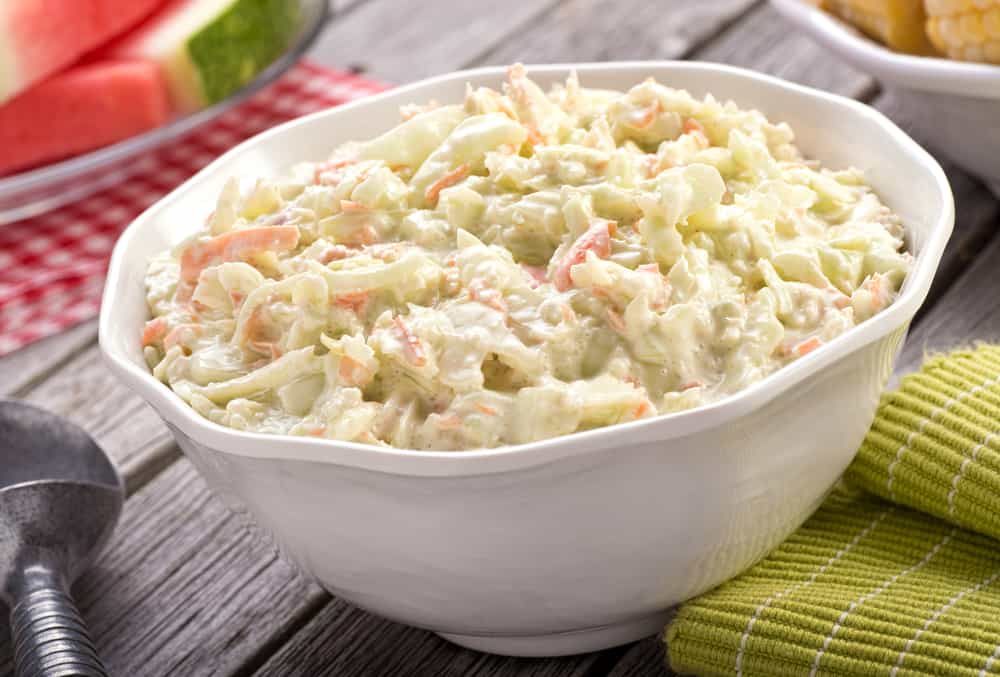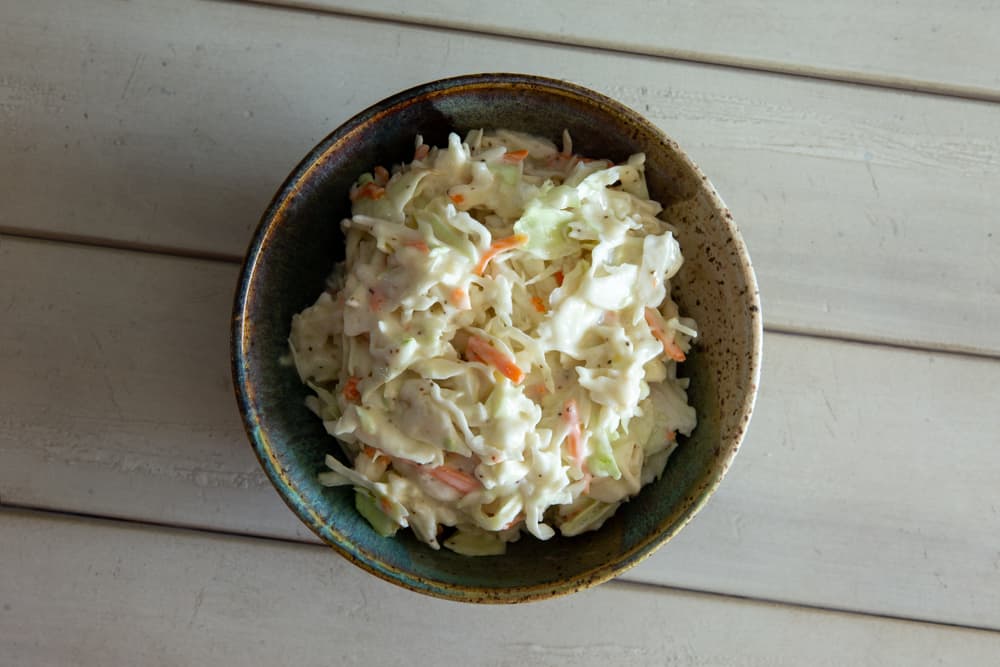It’s barbeque time. So you break out that large container of coleslaw you bought over the weekend or a bowl you made a few days ago, but some questions keep pestering your mind, “Is the coleslaw still okay to eat?” “Did I keep it in storage for too long?” Well, keep reading to find out.
Table of Contents
Does Coleslaw Go Bad?
Yes, coleslaw (whether store-bought or homemade) does go bad and can do so very quickly. It is one of the food items with a pretty short shelf life and must be stored properly to keep it fresh longer.
The salad’s main ingredient is cabbage and other veggies whipped with mayonnaise, sour cream, vinegar, and buttermilk. As such, just like any salad, coleslaw is highly perishable, and trying to hold onto it for an extended period is not a good idea.
The longer you keep it, the more it will lose its flavor and quality. The crispiness in the veggies will disappear and the whole thing will become very watery. While this doesn’t necessarily mean your coleslaw is spoiled, you may just want to toss it out, as the taste won’t be the same.
How Long Does Coleslaw Last?
Both store-bought and homemade coleslaw will have a relatively similar shelf life. However, the store-bought variety tends to last slightly longer. Most of the brands will include a best-by date – the salad will still taste okay two to three days after this date. Once a new container is opened, it keeps for between three and five days. Homemade coleslaw will stay good for three to five days.
Always store your coleslaw in the refrigerator, tightly sealed. For an off-the-shelf salad, check the best-before date on the package to know how long the product will stay good for. Beyond the recommended date, the salad will significantly lose its quality and won’t be that appealing.
Overall, how long your salad will last will depend on the ingredients used and how well you store it. Do not leave your salad out unless it is serving time. Disease-causing pathogens multiply rapidly at room temperature. Coleslaw should be thrown out if left at room temperature for more than two hours.
Here is a chart that illustrates the shelf life of coleslaw in a more simplified manner.
| Type of Coleslaw | Lifespan | |
| Refrigerator | Counter | |
| Unopened store-bought coleslaw | Best-by date + 2 to 3 days | 1 to 2 hours |
| Opened store-bought coleslaw | 3 to 5 days | 1 hour |
| Homemade coleslaw | 3 to 5 days | 1 hour |
5 Tips to Tell if Coleslaw Has Gone Bad
Because coleslaw does not contain any preservatives, it should be consumed quickly. Its ingredients are notorious for attracting microbial activities that accelerate the spoilage process. Without proper storage, the salad will start exhibiting signs of aging such as:
1. Strange Odor
Coleslaw will naturally smell sour because of the ingredients used. If yours contains lemon juice or vinegar, for instance, it will obviously have a sour odor, but that doesn’t mean it is spoiled. However, if you notice a significant change in smell, perhaps a sharp strong odor, that’s a sure sign that your coleslaw is done for.
2. Mold
Mold is one of the most noticeable signs of bad coleslaw. As soon as you see dark or gray spots, that whole salad has to be tossed out.
3. Change in Color
The color of fresh coleslaw will vary based on the ingredients. If your salad appears to have a different color from when it was fresh, stop second-guessing. It is spoiled and there’s no reason to continue keeping it.
4. Prolonged Storage
It’s okay to consume coleslaw two or three days after the best-by date. But if you have had the product sitting in storage for a much longer period, throw it out even if it still looks okay.
5. Horrible Taste
If everything looks good up to this point but you still want to know if your coleslaw is safe to eat, taste it. Spoiled coleslaw tastes awful. The sourness itself will be atrocious. Combine that with the wateriness and you won’t chew the salad more than once.
Important: Coleslaw will become watery and the vegetables will wilt after some time. While the salad may taste unpleasant, this is not a sign that it has spoiled. You can still safely consume it.
5 Tips to Store Coleslaw
Whether you will be consuming your coleslaw in a day or just a few hours, always make sure it is stored properly. Here are some tips to get you started:
1. Keep Coleslaw in the Refrigerator
Whenever you are not using your coleslaw, make sure it stays refrigerated. Of course, the salad will not go bad if you leave it out for a few minutes, but if it stays out for more than two hours, it will not be safe to ingest.
The longer the salad stays at room temperature, the more any bacteria that is inside can multiply and make the salad go bad before the due date. Cool temperatures slow down the growth of microbes, enabling the salad to last longer.
2. Seal It Tightly
Putting your coleslaw in an airtight container locks out smells from nearby foods, keeping it fresh. If the salad is in a large container, consider scooping all you need for the meal, then keep the rest in the refrigerator right away. Every second your coleslaw spends outside the fridge brings it much closer to its spoilage.
3. Use Clean Spoon
When handling coleslaw, make sure you are using clean utensils. For starters, ensure the container in which it is stored is clean. And when it comes to scooping, avoid using spoons that you have used with other foods. These can transfer food crumbs into the salad, making it vulnerable to molding.
4. Store Vegetables and Dressing Separately
If you are whipping your own coleslaw at home, consider prepping and storing the veggies and dressing in separate containers.
Shredded veggies can stay good for about a week in the refrigerator. If you prep them, say, on Saturday night, they will retain their quality throughout the week. Mix the veggies with the dressing when you want to eat.
5. Consider Wilting the Vegetables
One of the reasons coleslaw becomes watery after a few days is that the veggies contain too much water that is released into the salad after some time. Wilting can help solve this problem. Simply shred the veggies, add some salt, and let them wilt. After, put them in a salad spinner to dry.
Because the vegetables will lose most of their water, you will be able to enjoy your salad throughout its shelf life without worrying about it getting soggy and watery.
Want to learn how to make coleslaw that lasts up to 2 or 3 weeks? Check out this video:
The Risks of Consuming Expired Coleslaw
Spoiled coleslaw doesn’t just taste terrible; it can also make you sick. This is especially true if you leave the salad out near a heat source or on the kitchen counter for too long. Even if it doesn’t seem spoiled, coleslaw that is not stored properly can harbor pathogenic bacteria that may cause food poisoning.
Depending on the amount consumed, your age, and your health, you may experience vomiting, diarrhea, nausea, pain in the abdomen, dizziness, or even headaches.
Therefore, it is always a good idea to get rid of your coleslaw if it has been sitting out for too long or shows any other signs of spoilage. If you take coleslaw to a picnic, for example, don’t bring the leftovers back home. Similarly, if the salad has been in storage for way too long, it should go directly in the trash.
Can You Freeze Coleslaw?
Well, that will depend on the ingredients. If your coleslaw has mayonnaise, you will certainly not want to freeze it.
Why? Mayonnaise is an emulsion and will separate when the salad is thawed. You may still freeze the salad if separating is not an issue for you but the taste and texture after defrosting will not be the same. The best coleslaw to freeze will be the one that has a vinegar-based dressing.
If you do freeze your coleslaw, make sure the container is tightly sealed. When you are ready to consume it, defrost it overnight in the refrigerator.
It may help to portion the salad especially if it is in a large container and you plan to eat it every day. That way, you won’t have to thaw the entire container, as the constant defrosting and freezing can degrade its texture and make it watery. Also, keep the salad away from strong-scented foods so it doesn’t pick up their odors and flavors.
Summary
While coleslaw can be a great side dish, it doesn’t last long. Storing it in the refrigerator can help extend its shelf life, but the quality of the salad will still degrade after a few days. Be on the lookout for spoilage signs. If you see mold, a change in color, or if the salad starts to smell funny, put it in the trash.
Resources
- How Long Does Coleslaw Last?
- Does Coleslaw Go Bad? How Long Does Coleslaw Last?
- Does Coleslaw Go Bad and How Long Does It Last in The Fridge?
- How Long Does Coleslaw Last? Can It Go Bad?
- HOW LONG DOES COLESLAW LAST IN THE FRIDGE?


I would like to know what’s put in grocery store coleslaw, to make it safe to eat when you buy it, say, July 28, 2022 & the use by date is Sept 3?